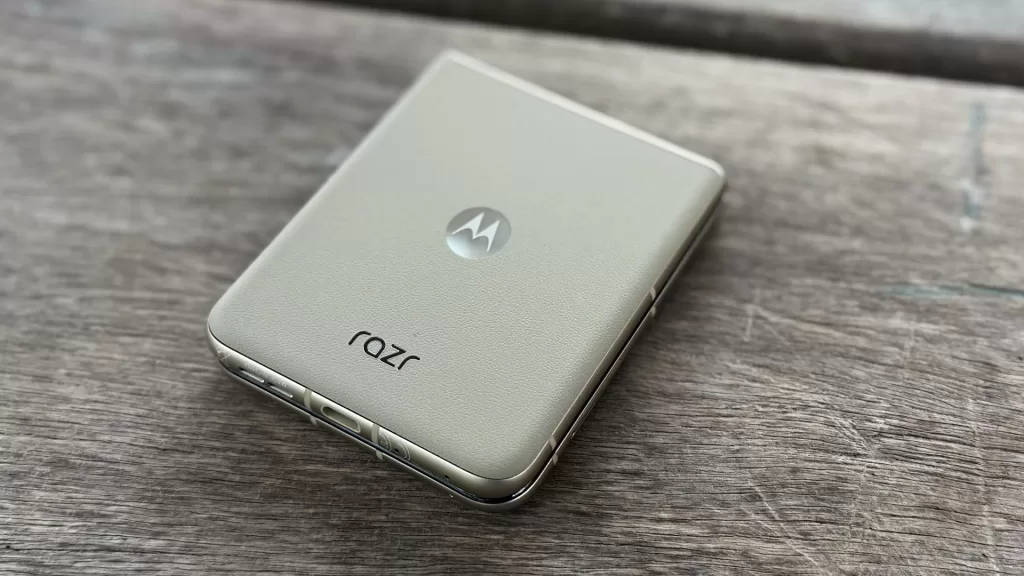
The redesign of the Motorola Razr 50 gives it a great external display for simpler app usage, but it could do with more of a power upgrade over the cheaper Motorola Razr 40.
| Pros | Cons |
|---|---|
| External Display works across many apps | More expensive than the Razr 40 was |
| Good battery life | Basically unchanged performance from the Razr 40 |
| 3 Android OS upgrades/ 4 years security updates | Average cameras |
Score: 3/5
In this review
Motorola Razr 50 Specifications
Motorola Razr 50 Design
Motorola Razr 50 Camera
Motorola Razr 50 Performance
Motorola Razr 50 Battery
Motorola Razr 50 Conclusion
While Samsung has been happy enough with a single flip foldable updated every year, Motorola has more recently had two offerings; a premium Razr “Ultra” model (confusingly called the “Razr+” in some markets) and an entry level Razr. Last year’s models there were the Razr 40 Ultra and Razr 40, both of which were phones I liked for different reasons.
Motorola launched the Razr 50 Ultra a while back, but it held off on the cheaper Razr 50 locally, even though it wasn’t quite as low-cost as the Razr 40 it’s replacing. I suspect that’s because the prime hook for the Razr 50 Ultra – its highly usable external display – is also present on the lower cost Razr 50.
However, the power difference between the two still leaves the Razr 50 Ultra in the command position as the best flip foldable you can buy right now, because while Motorola’s updated the external display on the Razr 50, it hasn’t done quite as much to boost processing performance or camera quality.
Also Read
Motorola Razr 40 Review
Motorola Razr 50 Ultra Review
Design
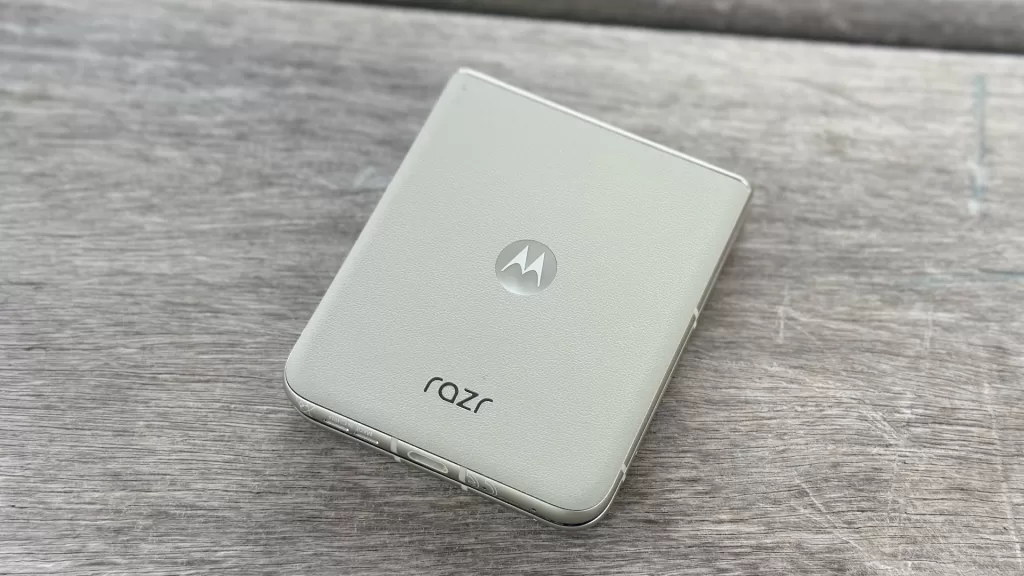
Like its predecessor, the Motorola Razr 50 is a small form factor flip foldable that presents as either a full screen mobile phone, or a smaller folded pocket square – more or less. That’s the same style used by the Motorola Razr 50 Ultra and competing Samsung Galaxy Z Flip6.
Where the Razr 50 differs from its predecessor most markedly is in the screen you get when it’s folded up. The Razr 40 only had a tiny 1.5 inch pOLED display, basically good for pager-style notifications and not much else.
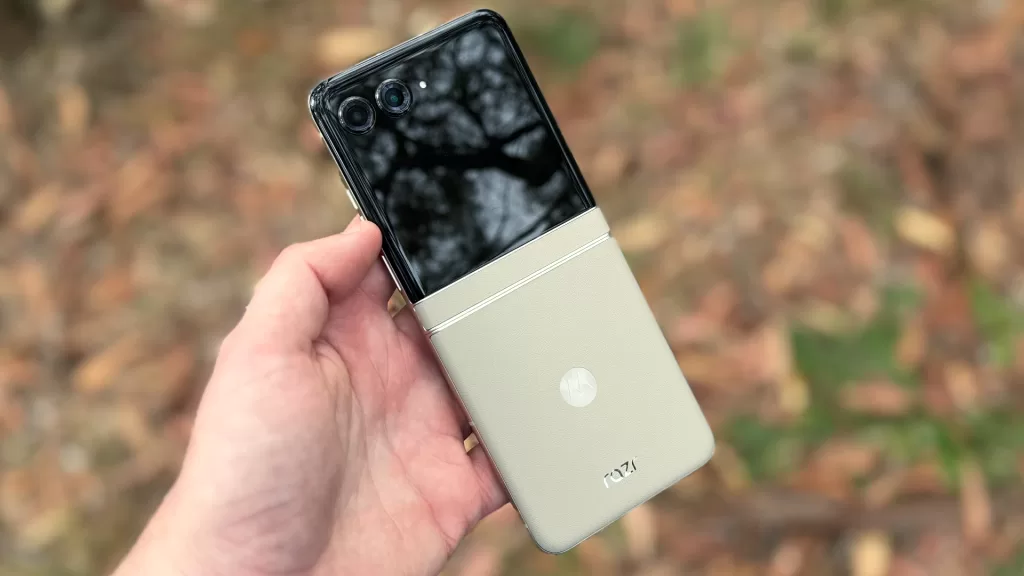
The Razr 50 features a 3.6 inch 90Hz capable pOLED display that’s essentially good for any Android app you’d care to throw at it – more on this later, but it is the big new design hook for the phone.

Unfold it and you’re faced with a 6.9 inch pOLED with a holepunch style notch for the “front” selfie camera. Well, one of them, the terminology gets downright weird when you have to try to describe where cameras sit on a folding phone.
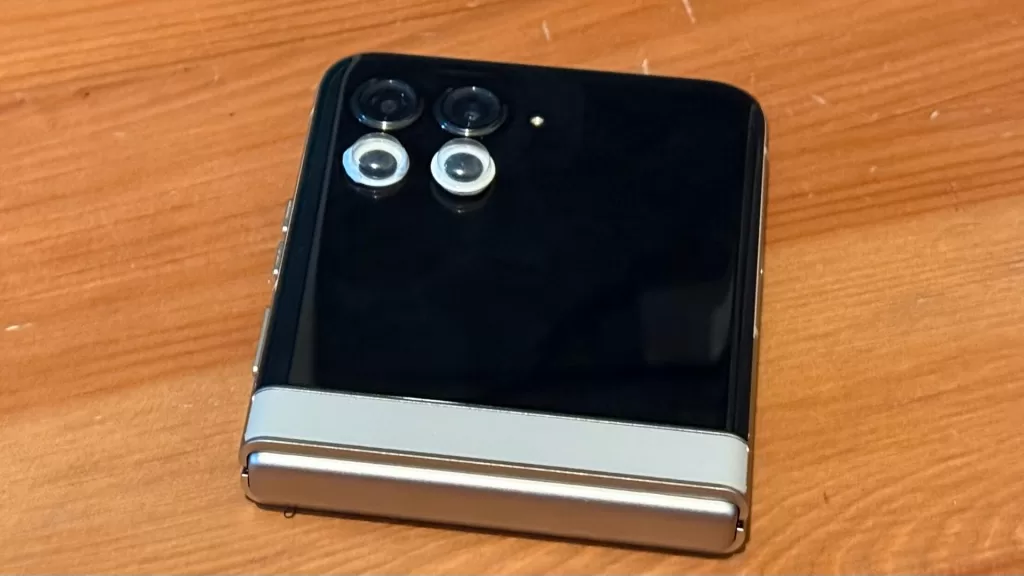
Adding googly eyes (optional) to the Razr 50 does allow you to call it "Four Eyes".
It's cruel to say it... but it's accurate too.
At the right side there’s your standard arrangement of volume buttons and a combination fingerprint reader/power button, while the left side houses the single Nano SIM card tray. USB-C power and data is at at the base, and that’s your lot for inputs.
In colour terms it appears that Motorola is bringing Australians all the colour choices it has, with Koala Grey, Beach Sand (light tan, basically) or Spritz Orange to choose from. Beach Sand is what Motorola loaned me for review.
Because of the nature of a folding compact phone, that colour is only really on the lower back plate, and I’m fine with that because (sigh) it’s wrapped in vegan leather. I think everyone knows I don’t like the feel of vegan leather by now, right?
At least there’s less of it for me to deal with, but if I were using it on an ongoing basis I’d want to look into case options.
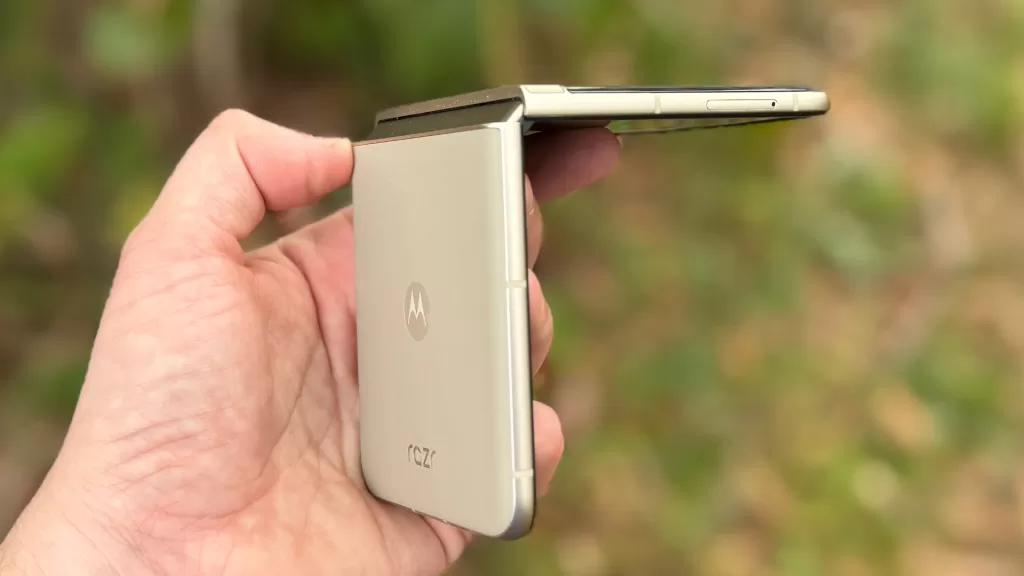
Notice how I'm trying to avoid the vegan leather part.
Mind you, this is a moderately more robust phone than the Razr 40 with a stated resistance of IPX8, which functionally means that it should survive dropping into water, but is much less inclined to get on well with sand, dust or grit.

This isn't a sensible way to hold the Razr 50, but it does show off the hinge nicely.
There is still something intrinsically pleasing about snapping a phone shut, and while earlier Razr models felt a little weak in this department, the Razr 50 has a genuinely fun snap to its closing action, supported by a nicely robust hinge.
No, I’ve not folded and unfolded it to the point where the screen snaps – I have slightly better things to do with my time – but it’s never not fun to finish up a phone call simply by snapping the phone shut.
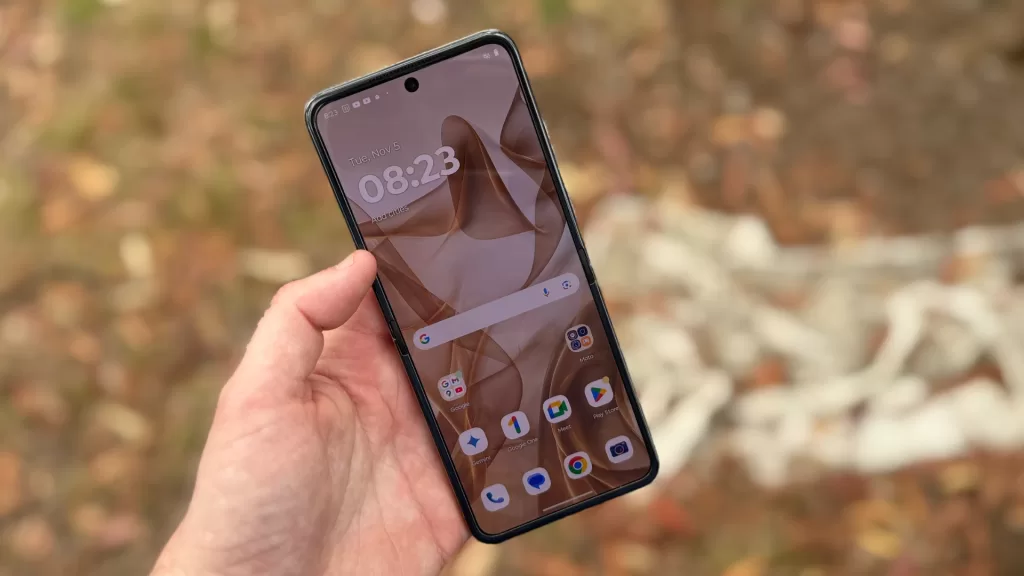
Motorola also brings its other moto actions to the Razr 50, so you can twist it to open the camera or shake it twice to fire up the flashlight. Just be aware that the nature of a folding phone means that the flashlight is often on the “front” of the folded up Razr 50, and the light is about to shine straight into your eyes.
Which is my way of admitting that I’ve done just that.
More than once.
I clearly need more coffee.
Camera
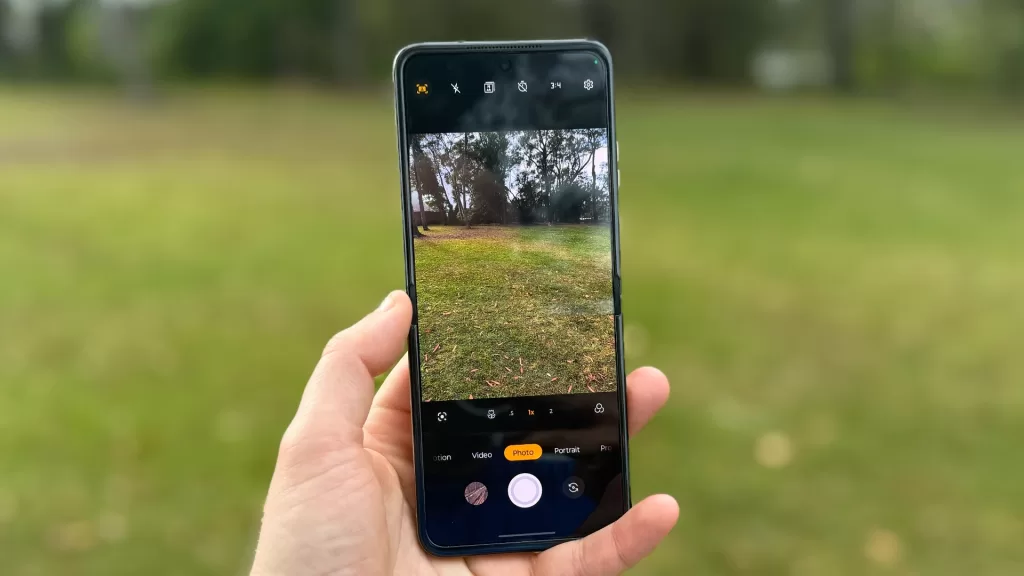
Flip phones have long frustrated me in camera terms, and that’s because it’s the one area where you pay a premium price for a phone but nearly always get slightly-less-than-premium performance.
On paper, the comparison between the Razr 50 and Razr 40 it replaces is an odd one. That’s because Motorola’s opted to switch out the 64MP Wide/13MP Ultra-Wide sensors on the Razr 40 with a 50MP Wide/13MP Ultra-Wide sensor pair on the Razr 50.
Photo quality isn’t purely determined by megapixel count, but it is unusual to see a brand step back this way for a successor product.
The obvious omission there is any form of telephoto lens. Tastes vary as to whether Ultra Wide or Telephoto is more useful, and I do tend to the latter, which was one of the reasons why I liked the Motorola Razr 50 Ultra so much. But that’s not what you get with the Razr 50, which has to rely on digital cropping of that primary 50MP lens for zoom style effects, up to a maximum of 10x zoom.
Predictably this doesn’t go well.

The Ultra Wide lens does a good job of adding a little drama to this otherwise dull landscape.
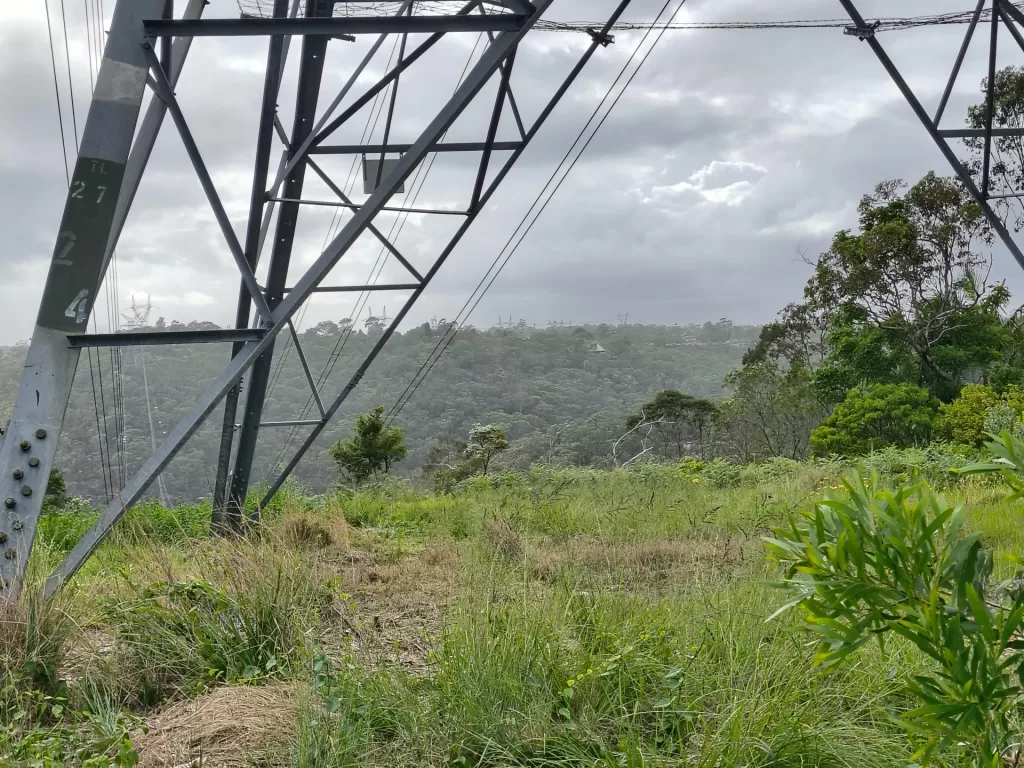
It’s less interesting at 2x, but it holds together well enough.

The same is not true at 10x. At all.
The Ultra Wide lens also does double duty (predictably) as a macro lens, and here the results are quite a lot better.

You don't want to know what he's seen -- and he won't say.

Even in natural photo mode, the Razr 50 tends to post-process for quite vibrant colour.
In my original review, I described the Razr 40 as “a phone that shoots fairly well in basic lighting situations” and… the same is essentially true of the Razr 50 as well.
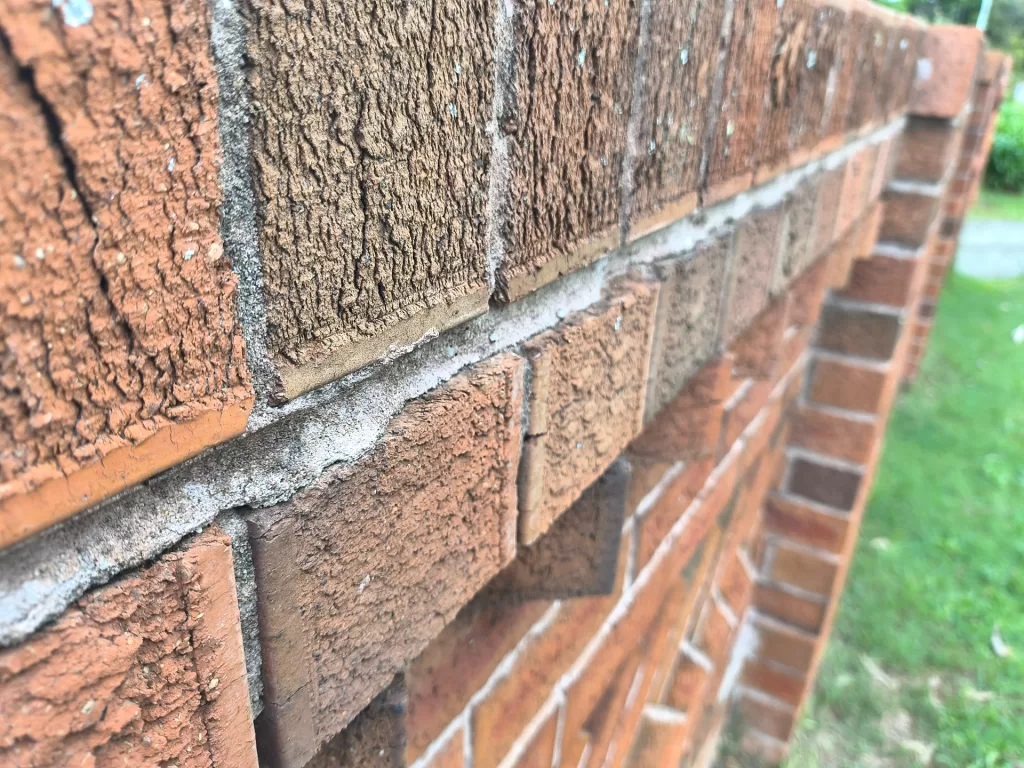
Like this wall, it's solid, but not exciting. Unless you get excited by brick walls, takes all sorts I suppose...
It’s not a powerhouse camera phone, and while you can do some interesting tricks with the dual screens to show subjects what you’re shooting, or hold it upside down to be a “camcorder” (of sorts), the end results are merely OK.
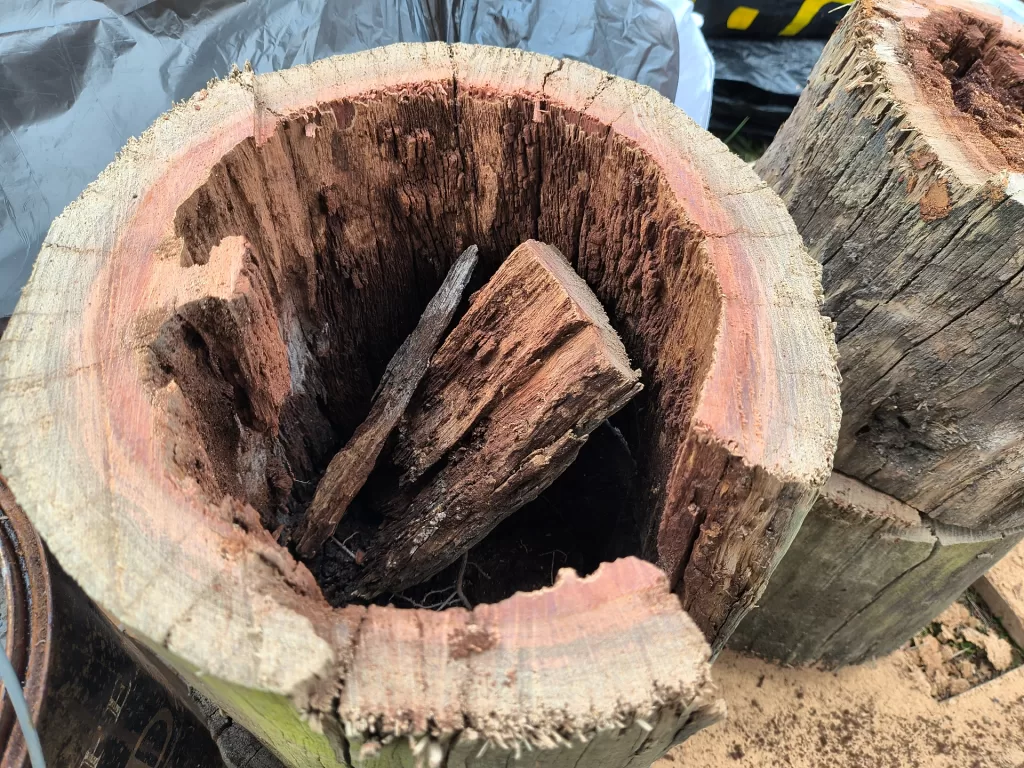
"Wood" I say the Razr 50 is the best flip camera phone? No. (Also, I have no pun regrets. At all.)
Is “OK” enough for a phone that costs $1,199?
It very much depends on how critical photography is to your smartphone experience. For everyday shots the Razr 50 will be more than enough for your needs, but even at the low end of the premium phone space, there’s just no denying that you can get better camera combinations than the Razr 50 can offer.
Performance

Last year’s Motorola Razr 40 relied on Qualcomm’s Snapdragon 7 Gen 1 processor, but this time round Motorola has jumped processor production camps, opting instead to drop a MediaTek Dimensity 7300X processor along with 8GB of RAM and 256GB of fixed storage.
Oddly, the SIM card tray is a longer type that makes it look like Motorola at least prototyped with an SD card slot – or perhaps there are dual SIM models in other markets.
MediaTek’s Dimensity processors are typically decent processors, but they’re rarely market leading, and that’s very apparent when the time came to benchmark the Motorola Razr 50. Here’s how it compared against a number of other folding phone options using Geekbench 6’s CPU test:
And here’s how it compares using 3DMark’s Wild Life Extreme Benchmark:
It is marginally better than the Motorola Razr 40 was in these tests, but by a margin that’s so close as to be effectively meaningless, and markedly lower than either of Motorola’s Razr Ultra phones, or any of Samsung’s most recent Flips and Folds.
This isn’t a complete disaster area; the Motorola Razr 50 is still a fair performer for most everyday tasks, but it’s not exactly sitting in a space where premium phones should play. If you are after more intensive app experiences, I’d definitely suggest saving your pennies up for the Motorola Razr 50 Ultra or Samsung Galaxy Z Flip6.
Where the Motorola Razr 50 does impress at a performance level is with its external display, because it allows the exact same sets of actions as the more expensive Motorola Razr 50 Ultra.
Where Samsung only officially supports widgets and a third party workaround to get apps working on the Galaxy Z Flip6’s lower resolution external display, Motorola basically just lets you try to run any app you’d like, while warning that some apps don’t really like being confined within a 3.6 inch display.
This is very powerful, because it shifts what the Motorola Razr 40 could do, which was basically just short notifications that always relied on you opening up the phone to take any action to a device where you can respond to messages or emails, take video calls, doomscroll to your (broken) heart’s content – basically whatever you’d like.
There are limits, and some apps such as higher-intensity games aren’t really that well suited to a display this small, but at least you’re able to try.

The Motorola Razr 50 is an Android 14 phone with the promise of 3 OS upgrades and 4 years of security updates. That's a slightly odd mix there, because if it was three years of OS upgrades, you might reasonably expect that it would see through to 2027's Android 18. However as it's already Android 14 with only three upgrades promised, that means it'll tap out at Android 17 instead.
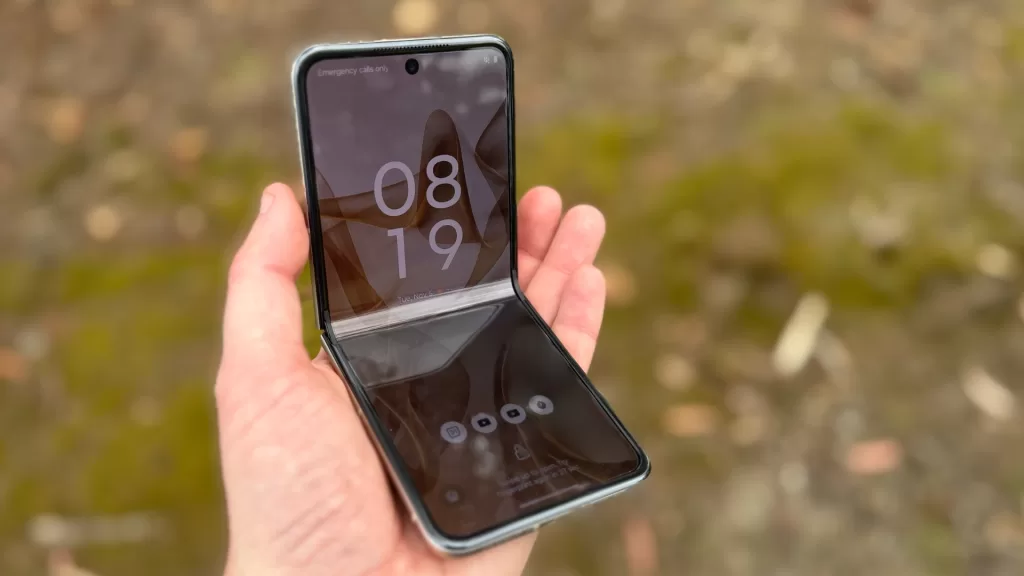
The Motorola Razr 50 also supports Google Gemini and its AI-assisted actions, and just as with every other phone with AI I’ve tested this year, I’m not magically sold on what AI is doing in the consumer space right now. It’s there if you want it, and while AI processes are improving as time goes by, it strikes me that the lower processing performance of the Razr 50 might not make it the best AI machine in the long term if that’s important to you.
Battery

The way folding phones are built does tend to somewhat constrict their battery capacities, and the Motorola Razr 50 is no exception. It ships with a 4,200mAh battery, which interestingly is a little bit larger than the battery pack found in the more expensive Motorola Razr 50 Ultra, which only has 4,000mAh of power to play with.
It is, as always, all about how you play with that power, however, because different app loads can make a huge difference to overall battery endurance. Here I turn to my standard one hour YouTube battery test, streaming a 1080p video at maximum brightness and moderate volume for an hour.
Historically Motorola’s foldable phones have done well in this test relative to their Samsung counterparts – and that’s true too for the Motorola Razr 50:
I’ve recently expanded this test out to three hours to gauge longer term battery endurance, but as yet I don’t have enough data on folding phones specifically for a meaningful comparison.
However, the Motorola Razr 50’s battery endurance shines through here anyway, with some of the best results I’ve seen from any smartphone, folding or not, in this test:
As with so many premium phones, there’s no in-box charger, but it does support wired charging at up to 30W or wireless charging at up to 15W.
Motorola Razr 50: Alex’s Verdict

Is the Motorola Razr 50 a better phone than the Razr 40?
If that’s the only question you want answered, then the answer is yes, but that affirmation rests on the fact that Motorola’s massively increased the external display, taking it from a simple notification banner to a full-fledged useful screen in its own right. Otherwise the upgrades are very minor indeed, and there’s an added complication in play.
When it launched here in Australia, the Razr 40 retailed at just $999, making it the lowest cost new flip foldable money can buy.
The Razr 50 retails at $1,199, some $200 more than its predecessor for a device that’s not faster or gifted with notably improved cameras either. The value of the update rests solely with that improved external display.
I’m not 100% sold that this is enough, especially with the Razr 50 Ultra providing a significant boost in processing power and camera optics as well.
While that’s an even pricier option at $1,699, you’re already playing in the premium pool buying the Razr 50 anyway, but the bump up in price will score you a significantly nicer flip foldable phone.
Was this review useful to you? Support independent media by dropping a dollar or two in the tip jar below!
Motorola Razr 50: Pricing and availability
The Motorola Razr 50 retails in Australia exclusively through Optus for $1,199.
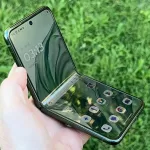 |
Buy The Motorola Razr 50 Ultra! | Buy On Amazon |















